2010 Porsche 911 Turbo – Click above for high-res image gallery
It's faster to 60 mph than a Lamborghini Murcielago LP640 or Ferrari Enzo. Porsche's fastest offerings, including the Carrera GT, GT2 and road-going 911 GT1 "Strassenversion" will only see its LED tail lamps during a typical sprint. Only the unlikely – make that incomprehensible – meeting of an SSC Ultimate Aero or Bugatti Veyron at a stop light will concern this car's owner that he or she has met a worthy adversary. The vehicle is the new seventh-generation 2010 Porsche 911 Turbo. Sporting a new 500-horsepower engine mated to the automaker's lightning-fast dual-clutch PDK transmission, the all-wheel drive coupe devours the magic 0-60 mph benchmark in less than 3.2 seconds.
Porsche invited us to a track outside Lisbon, Portugal to savor their latest Turbo iteration. While the physical appearance remains virtually unchanged to the uninformed eye, hidden under the familiar sheet metal is a new powertrain that makes one of the world's best sports car even more exceptional. What are the new mechanical specifications of the powerplant, and where does it come from? What's it like to drive on a track? Is the PDK transmission really better than the six-speed manual? Follow the jump for all of the answers...
Photos copyright ©2009 Michael Harley / Weblogs, Inc.
"Exclusive. Explosive. Expensive." Porsche's advertising slogan from the 1970s introducing its newest flagship 911 Turbo was blunt and to the point. First introduced in the middle of the oil crisis in 1974, the "Type 930" (Porsche's internal identification, although the vehicle was marketed as the "911 Turbo" or "Turbo Carrera" in most markets) was everything nobody needed.
Originally planned as a limited production run, the exotic "Turbo" featured advanced technology borrowed from the automaker's racing experience. A single exhaust-driven turbocharger boosted the original air-cooled 3.0-liter flat-six powerplant to 260 horsepower. Flared wheel arches, an oversized "whale tail" rear spoiler and brake technology originally developed for the legendary Porsche 917 race car helped round out the unique package. Porsche sold nearly 3,000 Turbo models during the first three years they were on sale, making it an unexpected success.
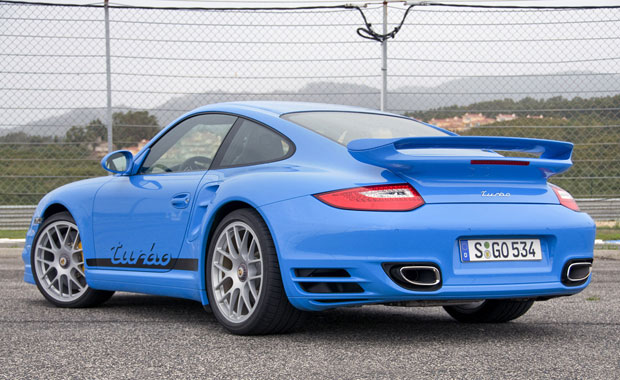
Over the next two decades, Porsche's 911 Turbo model became increasingly more tame and sophisticated as subsequent generations were introduced, yet each was faster and more powerful than its predecessor. The four-speed manual was replaced by a five-speed in 1989, improving drivability. A 3.6-liter air-cooled powerplant debuted in the 1993 Type 964 model, replacing the 3.3-liter. The laggy single turbo setup was improved with twin-turbochargers in 1995; the same year all-wheel drive replaced rear-wheel drive to more effectively put the power to the pavement.
All that history brings us to this: What Porsche is calling its seventh-generation 911 Turbo.
A significant change happened in 2001, when an all-new 420 horsepower water-cooled 3.6-liter powerplant debuted (variants of this "Metzger engine" would power the 911 Turbo, GT3 and GT2 for nearly another decade). The new engine was available with the Turbo's first automatic transmission (Porsche's Tiptronic) further increasing its customer base. Last year's model, the six-generation Type 997 (first introduced in 2006), was powered by a 480-horsepower variant of that very same engine.
All that history brings us to this: What Porsche is calling its seventh-generation 911 Turbo, although observers will note the platform is a carryover. Under the rear decklid of the new model is an all-new completely modern 3.8-liter water-cooled flat-six sharing architecture with the 3.8-liter normally-aspirated engine found in the current Carrera S. Along with its heart transplant, the Turbo benefits from a new dual-clutch transmission option, electronic engine mounts and retuned suspension with aluminum replacing steel in many of the components. These changes are significant enough to warrant its new model designation (Type 997.5), says Porsche.
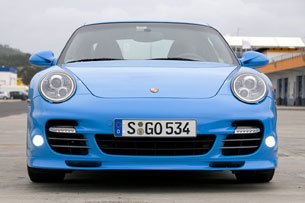
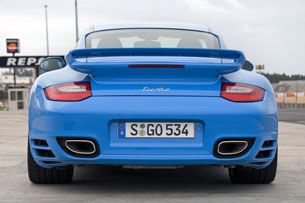
Cosmetically, the 2010 model has been tweaked ever so slightly. The titanium-colored louvers in the side intakes are new, as are the LED daytime driving lights on each side of the lower front spoiler. The headlamps are now dynamic (road following), the exterior mirrors improved, and new 19-inch forged wheels grace each corner (19-inch center-lock RS Spyder-inspired wheels are optional for the first time, just like on the GT3). The rear sports new LED lights and the tailpipes have been enlarged. Inside the cabin, a new three-spoke steering wheel on the PDK model is finally available with genuine, and proper, magnesium shift levers (right paddle to shift up, left paddle to shift down, huzzah!).
Under the rear decklid of the 2010 Turbo is the most powerful, and most fuel efficient, engine the automaker has ever offered in the model's 30-year history. Displacing 3.8-liters, the four-valve all-aluminum flat-six is fitted with direct fuel injection, an expansion-type intake manifold, and two turbochargers with variable turbine geometry. With a mild .8 bar (just under 12 psi) of boost, the engine is rated at an even 500 horsepower and 479 lb-ft of torque (the outgoing 3.6-liter engine produced 480 horsepower with nearly 15 psi of boost... and weighs 55 pounds more). An "overboost" feature (offered with the optional Sport Chrono Package on certain models) is able to punch torque up to 516 lb-ft for ten seconds, if needed.
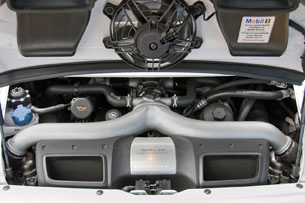
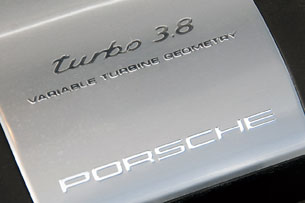
The news gets better. As is tradition, a manual transmission is standard (six-speed). However, Porsche has adapted its excellent seven-speed "doppelkupplungsgetriebe" (PDK) dual-clutch transmission for its new role in the 911 Turbo. The PDK gearing is longer for the Turbo, the clutches each have an additional shift plate, and the PDK is now available with a limited-slip differential (unlike the outgoing Tiptronic S transmission). Utilizing the PDK's "launch control" mode – which may be engaged as often as desired – Porsche conservatively quotes staggering acceleration numbers. From a standing start, 60 mph will arrive in 3.2 seconds (some reports peg it close to an even three seconds) with 124 mph eclipsed after just 11.3 seconds. Its top speed is 193 mph.
A Turbo Coupe will set you back about $143,000.
The recipe sounds good, but there's more. The cherry on this 911 Turbo is the new optional Porsche Torque Vectoring (PTV) mechanical rear axle. Working in conjunction with Porsche Traction Management (PTM) and Porsche Stability Management (PSM), the torque vectoring electronics discreetly brake the inside wheel during cornering to enhance agility and reduce understeer. A revised AWD system (power is distributed front to rear more smoothly) completes the powertrain package.
The standard Turbo Coupe wears a base MSRP of $132,800 with the mechanically identical Turbo Cabriolet placed at $143,800 (add a 150-pound weight penalty for its drop top and associated hardware). The PDK transmission is another $4,550 – and it really must be bundled with the Sport Chrono Package with Launch Control ($3,470), three-Spoke steering wheel with shift paddles adopted from the RS Spyder ($490), and the Porsche Torque Vectoring system ($1,320). While they're not necessary, Porsche's Ceramic Composite brakes ($8,840) are optional. Equipped properly (sans PCCBs, in our eyes), a Turbo Coupe will set you back about $143,000. Study hard in school, kids.
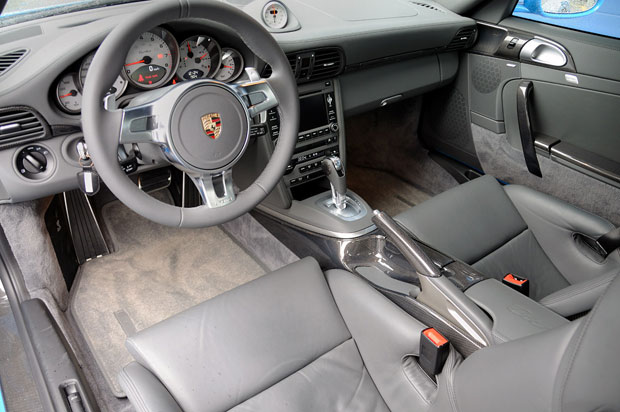
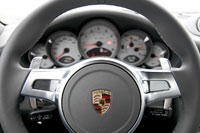
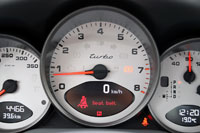
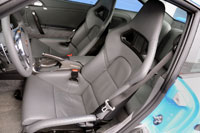
We were fortunate enough to spend a couple of days with the new Turbo at the famed Autódromo do Estoril race course, just outside Lisbon, Portugal. Sadly, our two particular calendar days were wrought with gut-wrenchingly miserable weather. Normally this area experiences a rather mild climate at this time of the year, but Mother Nature chose to dump several inches of rain on the track, and the surrounding Portuguese countryside, during our brief visit. It was only dry during our first orientation drive with the Turbo – the afternoon we arrived. The next day, with the heavens seemingly crying our own tears of disappointment, the road course had turned to a slippery mess which was understandably closed to everyone but the factory drivers. All was not lost, thankfully, as we gleaned more information from those few dry laps than the CIA did during early U-2 flights over the USSR.
In the grand scheme of things, the flagship 911 Turbo is not the track star of Porsche's lineup (the automaker has reserved the lighter and highly-tuned GT3 and now out-of-production GT2 for those roles). However, as was evident by our orientation lap at the hands of a skilled Porsche factory driver, the Turbo doesn't seem likely to acknowledge it. Here's how it went.
Riding on meaty rear 305/30ZR19 Bridgestone tires (235/35ZR19 up front), the 3,516-pound coupe launches out of the paddock with explosive kinetic energy. With the PDK cracking off gears in rapid succession, the Turbo is up to speed on the circuit in mere seconds.
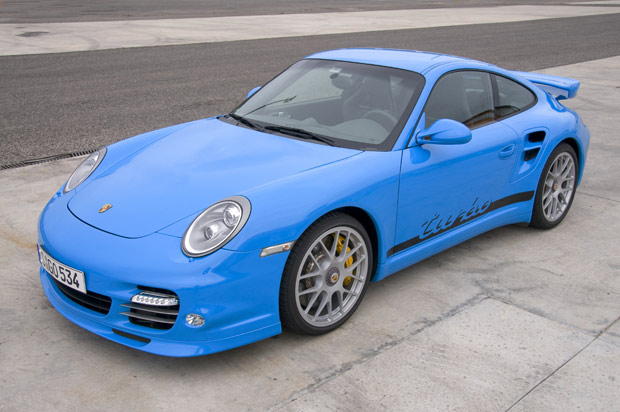
The first turn comes up fast. Little worry, as the American Le Mans Series veteran behind the wheel tosses the Turbo into the corner with a slight twitch. With its AWD system shredding the street tires, the Turbo maintains a slight oversteer approach as we fly past the apex. The power goes down hard and the PDK cracks off another gear as we exit the turn. We repeat the maneuver several more times before we round the corner to the straight. With a clean exit, the driver holds the pedal to the carpeted floor and lets the powertrain work its magic. In no time at all, the speedometer reads 262 km/h (162 mph). We start wondering why we left our helmets back in the garage.
It's docile to the novice, yet wickedly fun to the experienced driver.
Maximum braking from speed in a rear-engine Porsche 911 Turbo is unforgettable. The oversized six-piston monobloc calipers and cross-drilled iron heat sinks pick a fight with inertia – and easily win – as the mass of the flat-six slung out behind the rear wheels slams the rear tires down into the pavement to enhance grip. Porsche 911s don't pitch forward under braking – they hunker down.
We ran a couple laps ourselves. Pushed to the limit, yet operated like your driving instructor conventionally taught you back in high school, the 911 Turbo will safely understeer and scrub the outside front tire – your grandmother won't hurt herself. However, with some experience, that rear-engine configuration becomes an asset in a corner with a slow-in, fast-out driving style. With a bit of practice, weight may be held to the rear tires through delicate pedal applications and the car sticks tenaciously in the sweepers. Follow it with firm throttle off the apex, and the car rockets off the corner in a jaw-dropping manner.
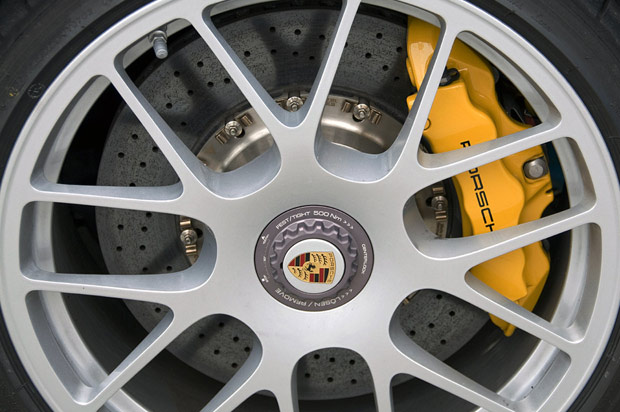
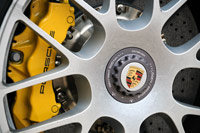
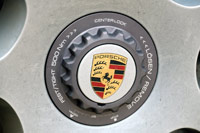
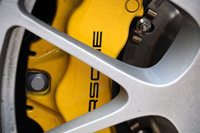
The next day, Porsche factory drivers took us out on the wet circuit – windshield wipers flailing – for a few more hot laps. At speeds that would make even a professional drifter nervous, the experienced professional racers tossed the 911 Turbo into four-wheel drifts clipping apexes while kicking wet rooster tails 20 feet into the air. It was all in good fun, but it demonstrated how adaptable Porsche's Turbo really is. It is docile to the novice, yet wickedly fun to the experienced driver.
The better part of one morning was spent in the countryside, now mostly dry from the sun peeking through the clouds. Touring through endless beautiful Portuguese villages (complete with hand-placed cobblestone roads) we sampled both the PDK and six-speed manual variants of the Turbo from their leather-lined cockpits and comfortable form-fitting front bucket seats. Although both were virtually identical except for the gearbox – each presented its own unique personality.
The PDK variant is everyone's Turbo. The aforementioned grandmother can sprint to 60 mph faster than nearly anything on the road, or she can drive it gently with a tall glass of Ensure in the dash-mounted cup holder – and not spill a drop.
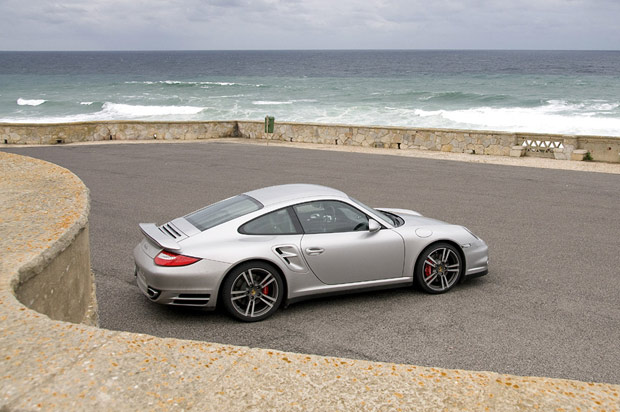
As the undisputed Dr. Jekyll and Mr. Hyde of the two variants, the PDK-equipped Turbo transforms from beast to angel with just two less inches of throttle pedal travel and a quick click to disable the console-mounted SPORT button. It's that easy. Drive it around town, in traffic, up steep hills, or down curvy canyons like a mindless Toyota Camry (on rails, of course), or instantly go into evil mode and devour the traffic around you. Commute to work in a suit during the week, and then take the Club Racing trophy in a helmet on the weekends. Versatility uber alles.
It is a bold statement, but the 911 Turbo with PDK is the world's best vehicle for passing. It's an honor we previously bestowed on the Nissan GT-R, an engineering masterpiece known for its explosive power and grip. While Godzilla would never be called a slouch, the nearly 350-pound lighter and quicker-shifting PDK-equipped Turbo instantaneously rewards a firmly depressed throttle pedal with a Mike Tyson punch in the backside. Seemingly suicidal short breaks in oncoming traffic become safe passing opportunities in the Porsche – often leaving the overtaken vehicle confused as to the blur that just rocketed by. Unlike nearly every other road-going vehicle, each requiring a few seconds of planning before initiating an overtaking maneuver, the Porsche Turbo PDK processes the command quicker than a dog snaps a Milk-Bone biscuit off its nose. There is no delay, no spooling up, no hesitation, no perceptible gear shifts – just a catapult launch of forward velocity. Porsche's PDK is an automatic we really like, and it's perfectly suited to the Turbo.
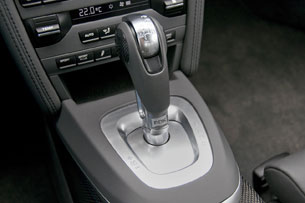
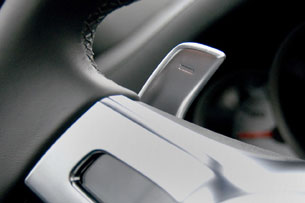
However impressed we were with the dual-clutch PDK, it was the three-pedals-on-the-floor model that won us over. As an enthusiast, there is something intimate – a close camaraderie with the vehicle – when you rest your hand on the manual transmission lever of such fine machinery. With all four limbs actively participating in the rhythmic dance of driving, the brain becomes another important cog within the machine. A flawlessly executed downshift feels great in a Honda Civic, but downright masterful in a 500-horsepower turbocharged Porsche.
Yet, while the vehicle feels even lighter underhand with the six-speed manual, the human body cannot change gears or rev-match as flawlessly as the dual-clutch computers. The turbo lag, electronically hidden with the PDK, is noticeable. No doubt you give up a few clicks on that sprint to legal speeds, a position or two on your average lap, and you will feel some turbo lag. But, one saves $9,000 by eliminating the PDK and Sport Chrono option and... operator involvement is what makes the 911 Turbo bona fide fun to drive.
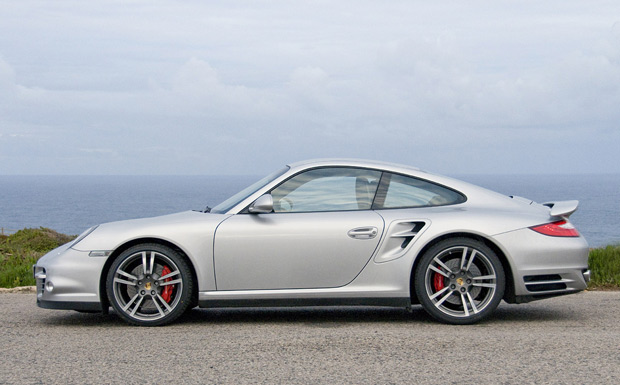
Porsche has been assembling the Turbo models for more than 30 years. Like any craftsman selling the same wares over three decades, each an improved iteration of its predecessor with little deviation from its original objective, the product has become polished nearly to the point of perfection – finding fault with this second-generation 997 Turbo purely as a grand touring sports car is a challenge.
The 911 Turbo is, and continues to be, a gentleman's sports car.
Some ceaselessly point to the Turbo's unconventional engine placement, or its smallish six-cylinder engine offering in a world of eight- and twelve-cylinder competitors. Those aren't faults or overlooked characteristics – each have been deliberately and meticulously engineered by Porsche and refined to perfection. Sure the back seat is bordering on unusable, the ergonomics are odd, and the twist key (not a push button) is still intentionally on the wrong side of the column... but that is the way Porsche intends it.
Dynamically, the 911 Turbo will run with the best from Maranello, Ingolstadt, Sant'Agata Bolognese and Gaydon. Yet, the unassuming coupe lacks the sexy stage presence of the Ferrari 430, Audi R8, Lamborghini Gallardo and Aston Martin DB9. Like the Mercedes-Benz SL63 AMG, an outstanding performer in its own right, the Porsche 911 Turbo is simply a cosmetic Average Joe in the supercar lineup.
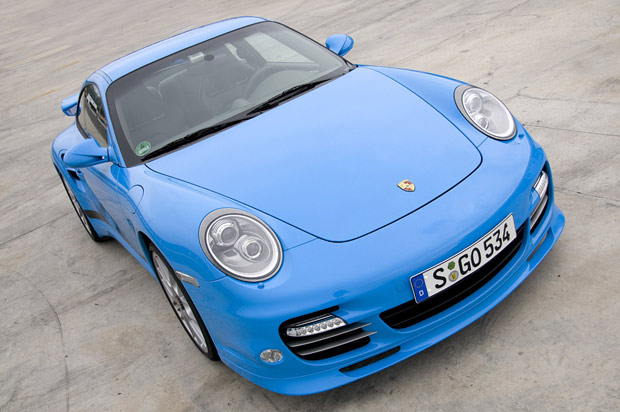
While others in this rarified segment boast booming exhaust notes, intimate cabins and cargo compartments only suitable for expensive fitted luggage, the Porsche bucks the trend. The 911 Turbo is, and continues to be, a gentleman's sports car with a tempered voice, upright seating position, excellent outward visibility and adequate cargo capacity. The original everyday supercar.
More than three decades in the making, and seven generations later, this two-door sports car is nearly perfectly cut and polished. The chassis and handling are extremely refined, the brakes tenacious, and the all-new 500 horsepower engine superlative regardless of transmission choice. Much as some may accuse the traditional 911 idiosyncrasies of being flaws, most feel they add ever important character and personality to this highly rewarding driving machine. From every facet, even under the most revealing light, the new 2010 Porsche 911 Turbo is a perfectly polished gem for all occasions.
Photos copyright ©2009 Michael Harley / Weblogs, Inc.
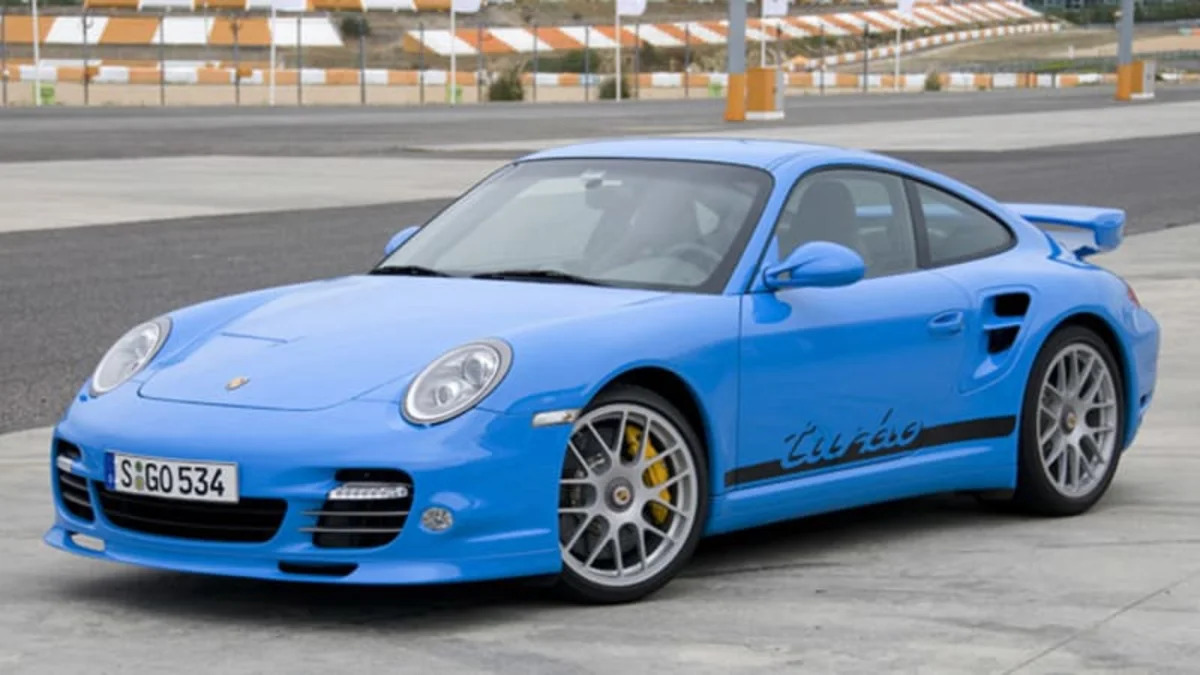


Sign in to post
Please sign in to leave a comment.
Continue